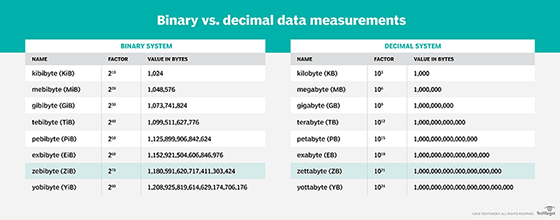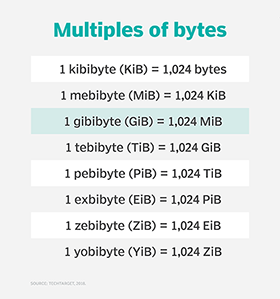exbibyte (EiB)
What is an exbibyte (EiB)?
An exbibyte (EiB) is a unit that measures data capacity.
The prefix exbi- was created as part of the binary system for computing and storage capacity measurement. It's based on powers of two, where one exbibyte equals 260 or 1,152,921,504,606,846,976 bytes.
The term exbibyte, like the other binary prefixes -- kibi-, mebi-, gibi-, tebi-, pebi-, zebi- and yobi- -- was developed by the International Electrotechnical Commission (IEC) in 1998.
Before the binary prefixes were created, IT used metric prefixes to measure computing capacity. This older measurement system is part of the International System of Units (SI) and includes the prefixes kilo-, mega-, giga-, tera-, peta-, exa-, zetta- and yotta-. The metric system of storage capacity prefixes is also referred to as the decimal system of prefixes.
History of the term
Prior to 1998, the SI system of prefixes was used for both the metric system's power-of-10 multipliers and the binary system's power-of-two multipliers. During those early decades of computing, context was the only way to determine whether the metric or the binary multiplier was being referred to when the term exabyte (EB) was used. That term referred to both metric and nonmetric units. That is, it could mean either 1018 (1,000,000,000,000,000,000) bytes or 260 (1,152,921,504,606,846,976) bytes.
Since the binary prefixes were developed in 1998, the system employed often depends on how it's being used. People in the communications, electronics and physics fields are more likely to use the metric system's power-of-10 decimal prefixes. Those working in IT and data storage are more likely to use the power-of-two binary prefixes.
Differences between metric and binary measurements
In the early days of computing, using the same prefix to refer to both the power-of-10 and the power-of-two multipliers was no problem. Data storage capacity was much smaller than it is today, and the difference between the values generated by the two systems was relatively small.
For example, using the metric system, 1 kilobyte (KB) of data capacity equals 1,000 bytes. Using the binary system, 1 KB of data equals 1,024 bytes. That's a 24-byte difference between the two systems, a negligible difference in many situations. But since those early days, data capacity has increased significantly, and the difference between the numbers generated by the two measurement systems has been magnified.
For instance, 1 EB of data using the metric power-of-10 system equals 1,000,000,000,000,000,000 bytes, while 1 EB of data using the binary power-of-two system equals 1,152,921,504,606,846,976 bytes. That's a difference of nearly 153 quadrillion bytes. As computing and storage capacities have increased, using the same prefixes for the different sets of numbers generated by the two measurement systems became a problem that could no longer be ignored.
Users of hard disk drives (HDDs) and solid-state drives (SSDs) faced one problem in particular. Drive makers used the power-of-10 metric system when they labeled the capacity of HDDs and SSDs. But the binary system was often used by operating system (OS) vendors to report storage and memory capacity. A hard drive manufacturer would label an HDD using the metric system as having 100 gigabytes (GB) of capacity. But then the computer OS, using the binary power-of-two system of measurement, would report the hard drive as having only 93.13 GB of capacity. Consumers were upset at losing what looked like nearly 7 GB of capacity before they had even used the HDD.
The IEC prefixes unveiled in 1998 for the binary system were supposed to clarify the situation. In the example above, the OS would have used the new binary system of prefixes instead of the metric system and reported 93.13 gibibytes (GiB) of capacity instead of 93.13 GB. By using the new prefixes, consumers could see that the OS vendor was using a different measurement system from the HDD manufacturer.

However, the new binary system prefixes aren't being widely used and haven't solved the capacity measurement problem. Academics, technical writers and open system developers make the most use of the IEC's binary prefixes, while commercial vendors and IT professionals are less likely to use them.
How large is an exbibyte?
At 1,152,921,504,606,846,976 bytes, an exbibyte is one of the larger measurements on the binary scale. It's larger than the following binary capacity measurements:
- A kibibyte (KiB) -- an EiB is equal to 1,125,899,906,842,624 KiB.
- A mebibyte (MiB) -- an EiB is equal to 1,099,511,627,776 MiB.
- A gibibyte -- an EiB is equal to 1,073,741,824 GiB.
- A tebibyte -- an EiB is equal to 1,048,576 TiB.
- A pebibyte -- an EiB is equal to 1,024 PiB.
Binary data capacity measures that are larger than an exbibyte include a zebibyte, which is 1,024 times the size of an EiB, and a yobibyte, which is 1,048,576 times the size of an EiB.
An EiB can store more than 1 quadrillion pages of plain text type.

Each consecutively higher prefix in the binary system of capacity measurement has 210, or 1,024, times the number of bytes of the next lower prefix. An exbibyte is 1,024 times the size of a pebibyte, and a zebibyte is 1,024 times the size of an exbibyte.
Exbibyte vs. exabyte
An exbibyte is more than 15.2% larger than 1 EB. That's a significant difference when talking about storage capacity.
At the lower capacities, such as kibibytes and kilobytes or mebibytes and megabytes, the differences between binary and metric units of measure are negligible. However, when comparing exbibytes and exabytes, the difference between the two systems is significant and must be considered.
Converting an exbibyte to a gigabyte
There are 1,152,921,504 GB in 1 EiB.
To convert exbibytes to gigabytes, multiply the number of exbibytes in question by the number of bytes in 1 EiB (1,152,921,504,606,846,976) and then divide by the number of bytes in 1 GB (1,000,000,000). That will provide the gigabyte equivalent of that amount of exbibytes.
A sampling of exbibyte-scale products
Products that scale in the exbibyte range aren't common. In 2012, object storage vendor Cleversafe said it had created a design for a 10 EB storage system for organizations performing big data analytics on unstructured data. The company said its design included portable, self-contained data centers distributed across 16 sites. Each site would have 35 data centers for a total of 560 portable data centers and 4.7 million disk drives. IBM acquired Cleversafe in 2015 and has since rebranded its products as IBM Cloud Object Storage.
Other vendors that claim exabyte-scale storage include Cloudian, Seagate and Vast Data.
Cloud storage could be an alternative option for obtaining an exbibyte of storage -- for example, through Google Cloud Coldline or Amazon Simple Storage Service Glacier.
Editor's note: This definition was revised in 2023 by TechTarget editors to improve the reader experience.





